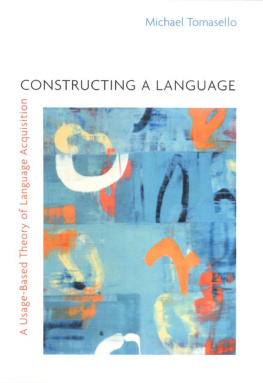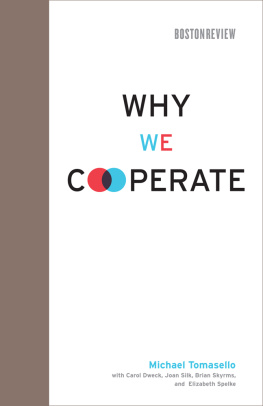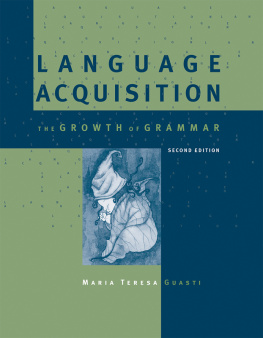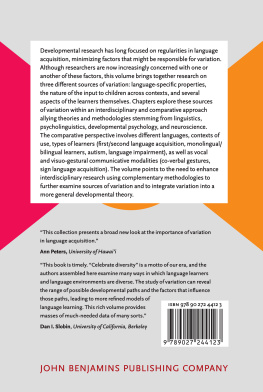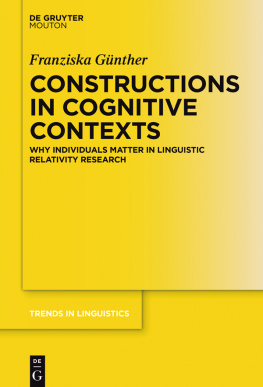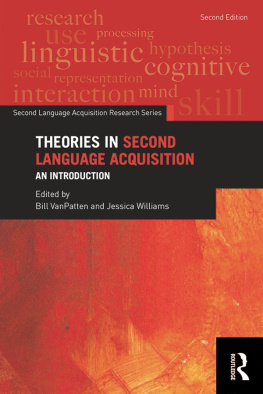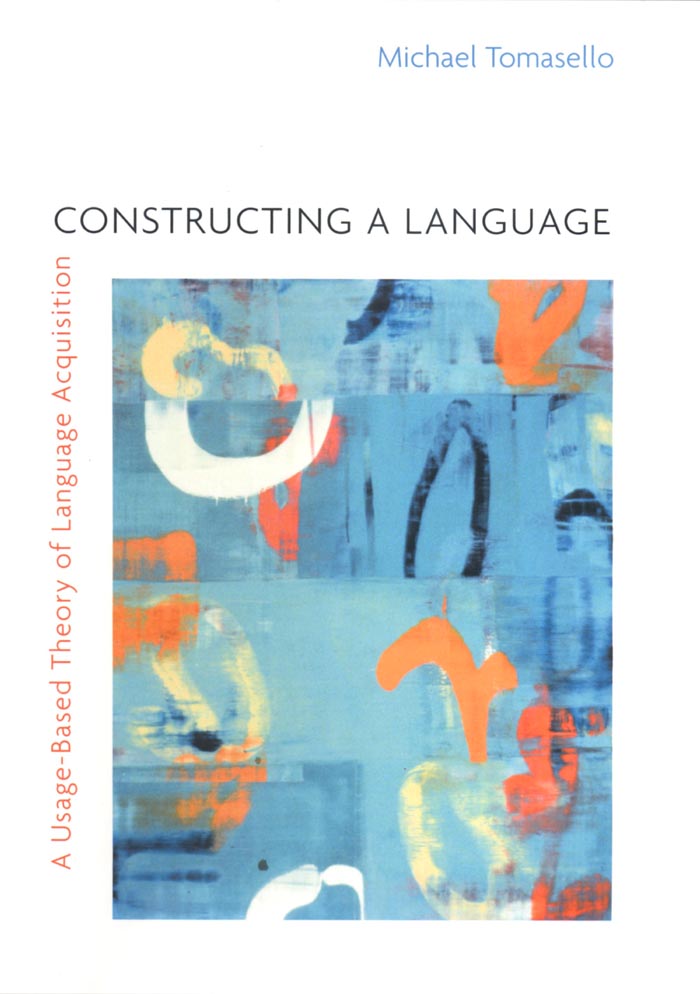
Constructing a Language
Constructing a Language
A Usage-Based Theory
of Language Acquisition
MICHAEL TOMASELLO
HARVARD UNIVERSITY PRESS
Cambridge, Massachusetts, and London, England
Copyright 2003 by Michael Tomasello
All rights reserved
Printed in the United States of America
First Harvard University Press paperback edition, 2005
Library of Congress Cataloging-in-Publication Data
Tomasello, Michael.
Constructing a language : a usage-based theory of language acquisition / Michael Tomasello.
p. cm.
Includes bibliographical references and index.
ISBN 0-674-01030-2 (cloth)
ISBN 0-674-01764-1 (pbk.)
1. Language acquisition. 2. Cognition in children I. Title.
P118 .T558 2003
4019.93dc21 2002038840
Designed by Gwen Nefsky Frankfeldt
For Liz Bates
Contents
1 Usage-Based Linguistics
2 Origins of Language
2.1. Phylogenetic Origins
2.2. Ontogenetic Origins
2.3. Childrens First Utterances
2.4. Summary
3 Words
3.1. Early Words and their Uses
3.2. Processes of Word Learning
3.3. Theories of Word Learning
3.4. Summary
4 Early Syntactic Constructions
4.1. The Nature of Constructions
4.2. Early Constructional Islands
4.3. Marking Syntactic Roles
4.4. Summary
5 Abstract Syntactic Constructions
5.1. Abstract Constructions
5.2. Constructing Constructions
5.3. Constraining Constructions
5.4. Theories of Syntactic Development
5.5. Summary
6 Nominal and Clausal Constructions
6.1. Reference and Nominals
6.2. Predication and Clauses
6.3. Learning Morphology
6.4. Summary
7 Complex Constructions and Discourse
7.1. Complex Constructions
7.2. Conversation and Narrative
7.3. Summary
8 Biological, Cultural, and Ontogenetic Processes
8.1. Dual Inheritance
8.2. Psycholinguistic Processes of Acquisition
8.3. Psycholinguistic Processes of Production
8.4. The Development of Linguistic Representations
8.5. Summary
9 Toward a Psychology of Language Acquisition
References
Acknowledgments
Index
ONE |
Usage-Based Linguistics |
The confusions which occupy us arise when language is like an engine idling, not when it is doing its work. |
LUDWIG WITTGENSTEIN |
NOTHING could seem less remarkable than a one-year-old child requesting More juice or commenting Doggie gone. But the remarkable fact is that even these baby utterances differ from the communicative activities of other animal species in a number of fundamental ways. For example, other animals do not refer one anothers attention to outside entities such as juice, they do not make disinterested comments to one another about missing doggies or the like, and they do not combine communicatively significant elements to create new meanings. But from an ethological perspective, perhaps the most astounding fact is that something on the order of 80 percent of all Homo sapiens cannot understand these simple utterances at all. That is, whereas the individuals of all nonhuman species can communicate effectively with all of their conspecifics, human beings can communicate effectively only with other persons who have grown up in their same linguistic communitytypically, in the same geographical region.
Whatever may be the evolutionary reasons for this unique, indeed bizarre, situation, one immediate outcome is that, unlike most other animal species, human beings cannot be born with any specific set of communicative behaviors. Young children must learn during their individual ontogenies the set of linguistic conventions used by those around them, which for any given language consists of tens of thousands, or perhaps even hundreds of thousands, of individual words, expressions, and constructions. The human species is biologically prepared for this prodigious task in ways that individuals of other species are not, of course, but this preparation cannot be too specific, as human children must be flexible enough to learn not only all of the different words and conventional expressions of any language but also all of the different types of abstract constructional patterns that these languages have grammaticized historically. It thus takes many years of daily interaction with mature language users for children to attain adult-like skills, which is a longer period of learning with more things to be learnedby many orders of magnitudethan is required of any other species on the planet.
The first proposal in the modern context was that young children learn their verbal behavior using the same garden-variety learning mechanisms they use to learn other behaviorswhich, by the way, are the same learning mechanisms used by rats and pigeons. Thus, Skinner (1957) proposed that young children learn pieces of language by means of instrumental conditioning (based on principles of association) and that they generalize to new instances by means of stimulus generalization (based on principles of induction). But in his withering review of Skinners book, Chomsky (1959) argued that there are some principles of grammar that are so abstract and, in a sense, arbitrary that children could not possibly learn them by means of simple association and induction. Indeed, Chomsky (1968, 1980a, 1986) later argued that there are some abstract principles of grammar for which children have no reliable and unambiguous evidence at allgiven that the language they experience consists of nothing more than a series of individual utterances. This is the so-called argument from the poverty of the stimulus, and Chomskys well-known solution was to hypothesize that human beings are born with an innate universal grammar containing a number of abstract principles that guide the acquisition process.
This argument had a profound effect on researchers studying childrens language in the 1960s and 1970s. The prevailing opinion at the time was that baby utterances such as More juice and Doggie gone were just that, baby utterances that rested on very concrete and seemingly non-adult-like linguistic representations such as More X and X gone (e.g., Braine, 1963, 1976). But people impressed with the argument from the poverty of the stimulus looked at these baby representations and at the formal descriptions of adult language being proposed by Chomsky and others and said, in effect: You cant get there from here (e.g., Gleitman and Wanner, 1982). The majority opinion in the field thus changed rather quickly to the view that childrens early language was somehow undergirded by some kind of linguistic abstractionsperhaps even the same ones that underlie mature adult language. This is the so-called continuity assumption: that basic linguistic representations are the same throughout all stages of child language developmentsince they come ultimately from a single universal grammar (Pinker, 1984).
But much has happened in the last two decades in developmental psychology, linguistics, and cognitive science which suggests a re-evaluation of the situation, that is, which suggests that children can get from here to there, and that they can do it without the aid of any hypothesized universal grammar. There are two fundamental points: (1) children have at their disposal much more powerful learning mechanisms than simple association and blind induction; and (2) there exist plausible and rigorous theories of language that characterize adult linguistic competence in much more child-friendly terms than does generative grammarwhich makes the endpoint of language acquisition seem much closer.
Next page
